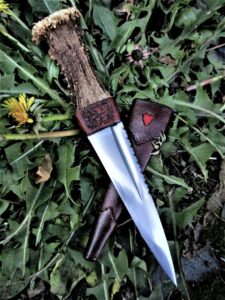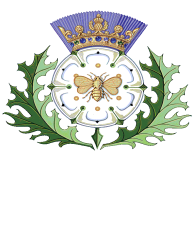The sgian dubh and scottish national dress – the facts!
Our friend and Founder Paul Macdonald have written this article to debunk Sgian Dubh myths.
 Hi Folks!
Hi Folks!
I have seen so much misinformation and myths shared in recent times about our traditional small knife, that I thought I’d address these and set some records straight. History – The sgian dubh does not originate from one, but two different historic forms of Highland knife. One of these was the Highland dagger (not the dirk, which is our traditional long knife), and another form with far more ancient origins (Iron Age) that developed over time to become the Drover’s knife and then the Gralloch knife (I explain all of these in greater detail in my illustrated presentation on Scottish Knives & Daggers!).
The sgian dubh only started to become more standardised in form throughout the C19th due to standardisation of Highland Regimental forms. Name, spelling and meaning – The knife is correctly called and spelled – Sgian Dubh (sgian = knife, dubh = dark) Pronunciation is phonetically something like sckeean doo. No other spelling variant however than the original Scottish Gaelic is correct for this knife. Many will tell you this means “black knife”, but more of an accurate translation into English would be “dark knife”.
 The dark attribution of the knife does not refer to the colour of the grip. Pre-C19th sgians usually had brown wood or stag antler grips. The dark term references its part-origins as a hidden or covert dagger, which was one of the arms carried and recognised in Highland martial culture. Wearing and Myths – The sgian dubh today is usually worn tucked into the top of one of your hose (the traditional long woolen socks worn with the kilt).
The dark attribution of the knife does not refer to the colour of the grip. Pre-C19th sgians usually had brown wood or stag antler grips. The dark term references its part-origins as a hidden or covert dagger, which was one of the arms carried and recognised in Highland martial culture. Wearing and Myths – The sgian dubh today is usually worn tucked into the top of one of your hose (the traditional long woolen socks worn with the kilt).
Pre-C19th covert versions were not worn here, but concealed under clothing such as inside a doublet (short jacket) or under a shirt sleeve. There is a common myth that the sgian dubh was taken out of a place of concealed carry and tucked into the hose when visiting a friend, but there is no historical evidence whatsoever to verify this. It appears to be an academic myth. Wearing the sgian tucked in the hose originates more accurately from late C18th – early C19th Highland Regimental standardisations which filtered more directly into civilian adoptions of regimental Highland dress. Legality in the UK – It is a commonly touted myth that it is illegal to wear or carry a sharp steel-bladed sgian dubh in the UK today while wearing national dress.
 This is nothing but erroneous misinformation. Section 139 of the Criminal Justice Act 1988 defines four defensible reasons in law for carrying any blade out-with that ordinarily acceptable (eg. 3″ blade length or less, folding and non-locking, such as a Swiss Army or pocket knife, these are perfectly legal to ordinarily carry). Three specific reasons stated are for religious reasons, for purpose/use at work and as part of any national dress. The fourth is for “reasonable excuse” ie. hunting, fishing, shooting, camping, etc.
This is nothing but erroneous misinformation. Section 139 of the Criminal Justice Act 1988 defines four defensible reasons in law for carrying any blade out-with that ordinarily acceptable (eg. 3″ blade length or less, folding and non-locking, such as a Swiss Army or pocket knife, these are perfectly legal to ordinarily carry). Three specific reasons stated are for religious reasons, for purpose/use at work and as part of any national dress. The fourth is for “reasonable excuse” ie. hunting, fishing, shooting, camping, etc.
If you are wearing Scottish national dress in the UK, you are perfectly within the law to carry a sgian dubh of any length or a dirk (our traditional long knife, worn on the belt and typically with a 12″ blade length) or both. The law cannot of course define or regulate exactly what constitutes Scottish national dress, but casual, casual-smart daywear, formal daywear and formal evening wear are all widely recognised as falling within acceptable variants of national dress. Private function venues such as bars and nightclubs as well as public events that employ security staff are however quite within their rights to refuse your blade entry, though most will be happy to secure and look after it for your duration within the premises.
 When travelling abroad via an airport, any sharp blades may be checked onto hold baggage without issue. The above laws stated here above apply throughout the UK. Other countries have their own blade carry laws which may vary, so it is always worth checking in advance if you plan to wear a sgian dubh or dirk with national dress internationally to avoid potential issues.
When travelling abroad via an airport, any sharp blades may be checked onto hold baggage without issue. The above laws stated here above apply throughout the UK. Other countries have their own blade carry laws which may vary, so it is always worth checking in advance if you plan to wear a sgian dubh or dirk with national dress internationally to avoid potential issues.
I hope that helps clarify some common myths, questions and perceptions regards the sgian dubh, its history, etymology and legality in the UK. Personally, I wear a dirk anytime I wear the kilt as I regard it as an important aspect of our cultural and martial heritage.

The only exception to this is when attending a good ceilidh! I have never had an issue wearing or carrying in public, particularly in the presence of Police and even Royalty.
Carrying any blade at any time is of course a social responsibility. It is not unusual for genuinely interested folk to ask about your blade and its making or history, and showing this in public is usually acceptable, but always a judgement call based on circumstances and company. If you wear our national dress either regularly or on occasion, carry those traditions in tartan and steel likewise with responsibility and pride!
Text and photo credit to: Paul Macdonald
Custom Sword and knife-maker, Macdonald Armouries
Master-at-Arms, Macdonald Academy of Arms
Armourer to the High Council of Clan Donald


